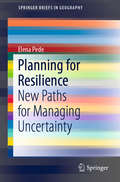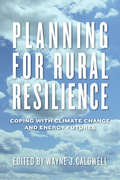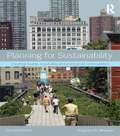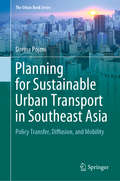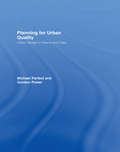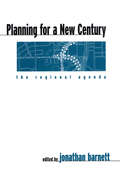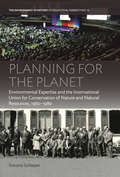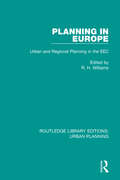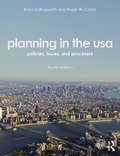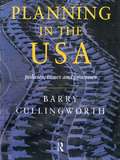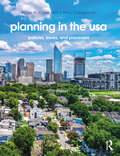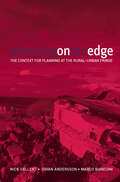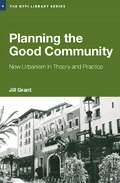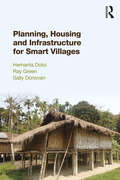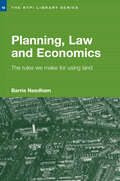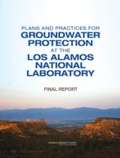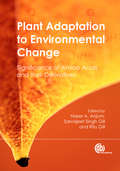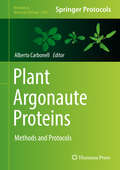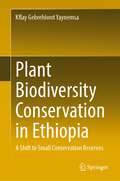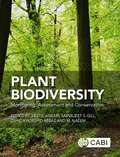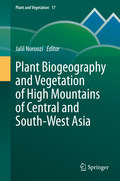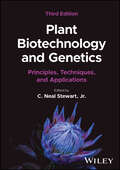- Table View
- List View
Planning for Resilience: New Paths for Managing Uncertainty (SpringerBriefs in Geography)
by Elena PedeGiven the increasing uncertainty due to catastrophic climate events, terrorist attacks, and economic crises, this book addresses planning for resilience by focusing on sharing knowledge among policy-makers, urban planners, emergency teams and citizens. Chapters look at the nature of contemporary risks, the widespread of resilience thinking and the gap between the theoretical conception and the practices. The book explores how resilience implies a change in planning practices, highlighting the need for flexibility in terms of procedures, and for dynamism in the knowledge systems and learning processes that are the main tools for interaction among different actors and scales. Given its breadth of coverage, the book offers a valuable resource for both academic readers (spatial planners, geographers, social scientists) and practitioners (policymakers, citizens’ associations).
Planning for Rural Resilience: Coping with Climate Change and Energy Futures
by Ralph Martin Chris White Wayne J. Caldwell Erica Ferguson Emanuel Lapierre-Fortin Jennifer Ball Suzanne Reid Paul Kraehling Eric Marr John Devlin Tony Mcquail Margaret Graves Bill Deen Christopher BryantClimate change and an evolving non-renewable energy sector threaten the future viability and sustainability of communities across the country. While rural communities have a special place in the national fabric, they often lack the resources to tackle these important and evolving threats. Planning for Rural Resilience: Coping with Climate Change and Energy Futures makes clear that communities and municipalities have opportunities to make informed and constructive decisions in the face of uncertainty: many of these decisions are “win-win” in the sense that they benefit the community in the short term while also building resilience for the future. Case studies include a town rebuilding itself after a tornado and an individual farmer’s commitment to creating a resilient farm. They provide examples of innovative, successful, and practical on-the-ground actions and strategies. Planning for Rural Resilience asks central questions about the nature of change and the ability to adapt in rural regions. While change is often feared, communities have capacity that can be rallied, harnessed, and turned towards planning policy and action that responds to threats to the future. This important work will assist municipal decision makers, planners, and community members as well as anyone who has a passion for the future and betterment of rural life.
Planning for Sustainability: Creating Livable, Equitable and Ecological Communities
by Stephen M. WheelerHow can human communities sustain a long-term existence on a small planet? This challenge grows ever more urgent as the threat of global warming increases. Planning for Sustainability presents a wide-ranging, intellectually well-grounded and accessible introduction to the concept of planning for more sustainable and livable communities. The text explores topics such as how more compact and walkable cities and towns might be created, how local ecosystems can be restored, how social inequalities might be reduced, how greenhouse gas emissions might be lowered, and how more sustainable forms of economic development can be brought about. The second edition has been extensively revised and updated throughout, including an improved structure with chapters now organized under three sections: the nature of sustainable planning, issues central to sustainable planning, and scales of sustainable planning. New material includes greater discussion of climate change, urban food systems, the relationships between public health and the urban environment, and international development. Building on past schools of planning theory, Planning for Sustainability lays out a sustainability planning framework that pays special attention to the rapidly evolving institutions and power structures of a globalizing world. By considering in turn each scale of planning—international, national, regional, municipal, neighborhood, and site and building—the book illustrates how sustainability initiatives at different levels can interrelate. Only by weaving together planning initiatives and institutions at different scales, and by integrating efforts across disciplines, can we move towards long-term human and ecological well-being.
Planning for Sustainable Urban Transport in Southeast Asia: Policy Transfer, Diffusion, and Mobility (The Urban Book Series)
by Dorina PojaniBy now, planners everywhere know - more or less - what the ingredients of a sustainable city are, in theory. The problem is that only bits of solutions are being implemented in the cities that most need them, the majority of which are located in the Global South. This book examines issues related to policy transfer in urban transport planning in Southeast Asia. The metropolitan regions of four major capitals - Jakarta, Kuala Lumpur, Manila, and Bangkok - are considered. The book assesses the in-bound and out-bound transfer of sustainable transport planning policies, concepts, and tools. The investigation focuses on who transfers policy and why, what elements of policy are transferred, in what direction and to what degree, and what barriers does transfer face. It also discusses how policy transfer processes in the transportation planning arena can be improved.
Planning for Urban Quality: Urban Design in Towns and Cities
by Michael Parfect Gordon PowerRapid regeneration of city areas has placed the quality of urban design high on public and policy agendas worldwide. Planning for Urban Quality examines the achievement of quality in the urban environment, in a planning context. Tracing urban design from its roots, the authors draw on both historical and current practices to examine the key physical, political and economic forces at play and the social pressures and impacts brought about by both failures and achievements in urban design. This highly illustrated critique of towns and cities draws on examples from across Western Europe, South Africa and USA to examine both public and private sector development practices, controls and fiscal policies within a diverse range of localities. The authors indicate the need for a reinstitution of region-provincial approaches, for closer co-ordination bewteen sectors, and revised fiscal policies in planning and development in order to enhance the quality of urban social experience and environments. Providing a deeper understanding of the many diverse strands of Urban Quality, the authors provide a firm basis from which to analyse urban planning achievements and to assess the relevance and value of urban scapes.
Planning for a New Century: The Regional Agenda
by Jonathan BarnettAcross the United States, issues such as sustainability, smart growth, and livable communities are making headlines. Planning for a New Century brings together leading thinkers in the fields of planning, urban design, education, welfare, and housing to examine those issues and to consider the ways in which public policies have helped create--and can help solve--many of the problems facing our communities. Each chapter identifies issues, provides background, and offers specific policy suggestions for federal, state, and local initiatives. Topics examined include: *the relation of existing growth management policies to social equity, as well as how regional growth management measures can make new development more sustainable *how an obscure technical procedure in highway design becomes a de facto regional plan *ways in which local governments can promote environmental preservation and better-designed communities by rewriting local zoning and subdivision ordinances *why alleviating housing shortages and slum conditions has resulted in a lack of affordable housing, and how that problem can be solved *how business improvement districts can make downtowns cleaner, safer, and more welcoming to workers and visitors In addition, the book features chapters on public safety, education, and welfare reform that include proposals that will help make regional growth management easier as inner-city crime is reduced, schools are improved, and concentrations of extreme poverty are eliminated. Planning for the New Century brings together current academic research with pressing public policy concerns, and will be a useful resource for policymakers at all levels of government, for planners and architects, and for students and scholars of urban planning and design, and urban studies.
Planning for the Planet: Environmental Expertise and the International Union for Conservation of Nature and Natural Resources, 1960–1980 (Environment in History: International Perspectives #16)
by Simone SchleperIn the 1960s and 1970s, rapidly growing environmental awareness and concern not only led to widespread calls for new policies, but also created unprecedented demand for ecological expertise. This led to novel challenges for advocacy groups such as the International Union for the Conservation of Nature, which had to navigate rival scientific approaches, Cold War politics, and decolonization in their efforts to integrate the study and protection of nature into international policymaking. This book reveals how, despite their vast scientific knowledge and attempts to incorporate socially relevant themes, experts inevitably struggled to make conservation a central part of environmental politics within intergovernmental organizations like the United Nations.
Planning for the Planet: Environmental Expertise and the International Union for Conservation of Nature and Natural Resources, 1960–1980 (Environment in History: International Perspectives)
by Simone SchleperDuring the 1960s and 1970s, rapidly growing environmental awareness and concern created unprecedented demand for ecological expertise and novel challenges for ecological advocacy groups such as the International Union for Conservation of Nature and Natural Resources (IUCN). This book reveals how, despite their vast scientific knowledge and their attempts to incorporate socially relevant themes, IUCN experts inevitably struggled to make global schemes for nature conservation a central concern for UNESCO, UNEP and other intergovernmental organizations.
Planning in Europe: Urban and Regional Planning in the EEC (Routledge Library Editions: Urban Planning #22)
by R. H. WilliamsOriginally published in 1984 Planning Urban Europe is a volume of essays reviewing the systems of town and country planning that operate within the member-states of the European Economic Community. The book looks at how the community’s institutions and policies relate to the activity of planning and contributions are written by experts native to the country of study. Each contribution focuses on the scope and style of planning in that country, as opposed to detailed accounts of planning legislation. The book will be of value to practitioners, students and officials wanting to gain an insight into planning elsewhere in Europe.
Planning in the USA
by Roger Caves J. Barry CullingworthThis extensively revised and updated fourth edition of Planning in the USA continues to provide a comprehensive introduction to the policies, theory and practice of planning. Outlining land use, urban planning, and environmental protection policies, this fully illustrated book explains the nature of the planning process and the way in which policy issues are identified, defined, and approached. This full colour edition incorporates new planning legislation and regulations at the state and federal layers of government, updated discussion on current economic issues, and examples of local ordinances in a variety of planning areas. Key updates include: a new chapter on planning and sustainability; a new discussion on the role of foundations and giving to communities; a discussion regarding the aftermath of Katrina in New Orleans; a discussion on deindustrialization and shrinking cities; a discussion on digital billboards; a discussion on recent comprehensive planning efforts; a discussion on land banking; a discussion unfunded mandates; a discussion on community character; a companion website with multiple choice and fill the blank questions, and 'test yourself' glossary terms. This book gives a detailed account of urbanization in the United States and reveals the problematic nature and limitations of the planning process, the fallibility of experts, and the difficulties facing policy-makers in their search for solutions. Planning in the USA is an essential book for students, planners and all who are concerned with the nature of contemporary urban and environmental problems.
Planning in the USA: Policies, Issues and Processes
by Barry CullingworthPlanning in the USA is a comprehensive introduction to the policies, theory and practice of planning. outlining land use, urban planning and environmental protection policies, this fully illustrated book explains the nature of the planning process and the way in which policy issues are identified, defined and approached.Planning in the USA offers a detailed account of urbanization in the USA. Focussing on policies relating to land use, urban planning and environmental protection, Barry Cullingworth reveals the problematic nature and limitations of the planning process, the fallibility of experts, and difficulties facing policy-makers in their search for solutions.Coverage includes:Land Use Regulation Transport, Housing and Community Development Public Attitudes to Planning Property Rights Environmental Planning and PoliciesGrowth Management Planning and Governance Planning problems are seldom easily solved. Barry Cullingworth's Planning in the USA is an essential book for students and planners and all who are concerned with the nature of contemporary urban and environmental problems.
Planning in the USA: Policies, Issues, and Processes
by J. Barry Cullingworth Roger W. CavesExtensively revised and updated, Planning in the USA, fifth edition, continues to provide a comprehensive introduction to the policies, theory, and practice of planning. Outlining land use, urban planning, and environmental protection policies, this fully illustrated book explains the nature of the planning process and the way in which policy issues are identified, defined, and approached. The new edition incorporates new planning legislation and regulations at the state and federal layers of government and examples of local ordinances in a variety of planning areas. New material includes discussions of • education and equity in planning; • the City Beautiful Movement; • Daniel Burnham’s plan for Chicago; • segregation; • Knick v. Township of Scott; • reforming single-family zoning and regulatory challenges in zoning and land use; • Daniel Parolek’s ‘Missing Middle Housing’; • climate change, mitigation, adaptation, and resiliency; • the drinking water crisis in Flint, Michigan; • sharing programs for cars, bicycles, and scooters; • hybrid electric and autonomous vehicles; • Vision Zero; • COVID-19 relief for housing; • Innovation Districts, Promise Zones, and Opportunity Zones; • the sharing, gig, and creative economies; • scenic views and vistas, monuments, statues, and remembering the past; and • healthy cities, Health Impact Assessment, and active living. This detailed account of urbanization in the United States reveals the problematic nature and limitations of the planning process, the fallibility of experts, and the difficulties facing policy-makers in their search for solutions. Planning in the USA, fifth edition, is an essential book for students of urban planning, urban politics, environmental geography, and environment politics. It will be a valuable resource for planners and all who are concerned with the nature of contemporary urban and environmental problems.
Planning on the Edge
by Johan Andersson Nick Gallent Marco BianconiMore than a tenth of the land mass of the UK comprises 'urban fringe': the countryside around towns that has been called 'planning's last frontier'. One of the key challenges facing spatial planners is the land-use management of this area, regarded by many as fit only for locating sewage works, essential service functions and other un-neighbourly uses. However, to others it is a dynamic area where a range of urban and rural uses collide. Planning on the Edge fills an important gap in the literature, examining in detail the challenges that planning faces in this no-man’s land. It presents both problems and solutions, and builds a vision for the urban fringe that is concerned with maximising its potential and with bridging the physical and cultural rift between town and country. Its findings are presented in three sections: the urban fringe and the principles underpinning its management sectoral challenges faced at the urban fringe (including commerce, energy, recreation, farming, and housing) managing the urban fringe more effectively in the future. Students, professionals and researchers alike will benefit from the book's structured approach, while the global and transferable nature of the principles and ideas underpinning the study will appeal to an international audience.
Planning the Good Community: New Urbanism in Theory and Practice (RTPI Library Series)
by Jill GrantAn examination of new urban approaches both in theory and in practice. Taking a critical look at how new urbanism has lived up to its ideals, the author asks whether new urban approaches offer a viable path to creating good communities. With examples drawn principally from North America, Europe and Japan, Planning the Good Community explores new urban approaches in a wide range of settings. It compares the movement for urban renaissance in Europe with the New Urbanism of the United States and Canada, and asks whether the concerns that drive today’s planning theory – issues like power, democracy, spatial patterns and globalisation- receive adequate attention in new urban approaches. The issue of aesthetics is also raised, as the author questions whether communities must be more than just attractive in order to be good. With the benefit of twenty years’ hindsight and a world-wide perspective, this book offers the reader unparalleled insight as well as a rigorous and considered critical analysis.
Planning, Housing and Infrastructure for Smart Villages
by Sally Donovan Ray Green Hemanta DoloiSome 7.3 billion people currently live on the planet. Of these, 3.4 billion live in rural areas. In just a few regions—Latin America, the Middle East and North Africa—less than 50 per cent of poverty is now located in rural areas. But for the rest of the world's regions between 55 per cent and 80 per cent of the poor continue to live in the countryside. Progress is being made, but much of the knowhow needed is not disseminated outside of a small coterie of professionals who work in the area. With urban development attracting a great deal of attention lately, poorer rural areas deserve the same and new knowledge for empowerment of rural communities is urgently needed. This book provides an overview of current thinking and practices that have emerged over the last thirty years for uplifting rural communities in developing economies. Drawing on a body of knowledge across a spectrum of relevant disciplines, this book provides a range of innovative ideas for rural planning, housing and infrastructure development. Governments in many emerging economies, where rural poverty is often most acute, have attempted to improve livelihoods. Approaches and techniques that have been used for urban development are often not applicable to rural communities. Studies show that money allocated for rural development is often not effectively spent due to distance, lack of infrastructure, lack of education, poverty and other factors. Meanwhile, the gap in development between the city and country continues to grow, sometimes leading to social and political instability, in both developing and developed countries. This book seeks to provide a guidebook for meeting such challenges. Through in-depth enquiry of global practices and thinking about rural development, and selected case studies, the authors argue that careful consideration must be given to incorporating issues of resilience, resourcefulness and the involvement of communities at grassroots levels in realising the transformation of rural settlements into Smart Villages.
Planning, Law and Economics: The Rules We Make for Using Land (RTPI Library Series)
by Barrie Needham Edwin Buitelaar Thomas HartmannPlanning, Law and Economics sets out a new framework for applying a legal approach to spatial planning, showing how to improve the practice and help achieve its aims. The book covers planning laws, citizens' rights and property rights, asking ‘What rules do we want to make and, where necessary, enforce? And how do we want to apply them in planning practice?’ This book sets out, in general and illustrated with concrete examples, how the three types of law mentioned above are unavoidably involved in all types of spatial planning. The book also makes clear that these laws can be combined in different ways, each way a particular approach to the practice of spatial planning (regulative planning, structuring markets, pro-active planning, collaborative planning, etc.). Throughout, the book shows what legal approaches can be taken to spatial planning, and uses a four-part framework to evaluate the effects of choosing such an approach. The spatial planning should be effective, legitimate, morally just and economically sound. In particular the book details why the economic effects for society are important and how spatial planning affects how the economic resources of land and buildings are used. The book will be invaluable to students and planners to understand the relationship between their actions and the basic principles of the rule of law in a democratic, liberal society.
Planning, Law and Economics: The Rules We Make for Using Land (RTPI Library Series)
by Barrie NeedhamWhat rights does the state have over privately owned land? Why should some landowners be favoured over others? How can the practice of land-use planning be improved? This book addresses these essential questions and shows that the interests people have in property rights over land and buildings are not just emotional but often financial too. It follows that the law, which affects who has property rights, what those rights are and how they may be used, can have great financial consequences for people and great economic consequences for society in general. For those reasons, looking at land-use planning as it affects and is affected by property rights illuminates some core aspects of land-use planning, including the law, economics, ethics and ideology. In this book, Needham examines those aspects from the clear perspective of property rights.
Plans And Practices For Groundwater Protection At The Los Alamos National Laboratory: Final Report
by National Research Council of the National AcademiesThe National Academies Press (NAP)--publisher for the National Academies--publishes more than 200 books a year offering the most authoritative views, definitive information, and groundbreaking recommendations on a wide range of topics in science, engineering, and health. Our books are unique in that they are authored by the nation's leading experts in every scientific field.
Plant Adaptation to Environmental Change
by Sarvajeet Singh Gill Firdaus Bareen Masayuki Fujita A Aziz Antonio Márquez Antonio Tiburcio Oscar Ruiz Vera Alexieva Bhaskar Gupta B. Vidya Vardhini Renu Bhardwaj Ritu Gill Penna Suprasanna Yoshikatsu Murooka Naser A Anjum Jose Luis MartinezPlants constantly cope with unfavourable ecosystem conditions, which often prevent them reaching their full genetic potential in terms of growth, development and productivity. This book covers plants' responses to these environmental changes, namely, the modulation of amino acids, peptides and amines to combat both biotic and abiotic stress factors. Bringing together the most recent developments, this book is an important resource for researchers and students of crop stress and plant physiology.
Plant Adaptation to Environmental Change: Significance of Amino Acids and their Derivatives
by Firdaus Bareen Masayuki Fujita A Aziz Antonio Márquez Antonio Tiburcio Oscar Ruiz Vera Alexieva Bhaskar Gupta B. Vidya Vardhini Renu Bhardwaj Penna Suprasanna Yoshikatsu Murooka Jose Luis MartinezPlants constantly cope with unfavourable ecosystem conditions, which often prevent them reaching their full genetic potential in terms of growth, development and productivity. This book covers plants' responses to these environmental changes, namely, the modulation of amino acids, peptides and amines to combat both biotic and abiotic stress factors. Bringing together the most recent developments, this book is an important resource for researchers and students of crop stress and plant physiology.
Plant Argonaute Proteins
by Alberto CarbonellThis volume provides the reader with step-by-step methods to study plant ARGONAUTE (AGO) functions. Chapters in Plant Argonaute Poteins: Methods and Protocols summarize the main biochemical, molecular and cytological methods to study AGO-small RNA complexes and their interactions with target RNAs, AGO subcellular localization, AGO association with polysomes, AGO role in meiosis and DNA repair, methods for the identification, cloning and characterization of AGO genes in different plant species, and non-radioactive protocols for small RNA detection. Finally, a series of chapters describing computational methods to study plant AGO function and evolution are provided. Written in the highly successful Methods in Molecular Biology series format, chapters include introductions to their respective topics, lists of the necessary materials and reagents, step-by-step, readily reproducible laboratory protocols, and tips on troubleshooting and avoiding known pitfalls. Authoritative and practical, Plant Argonaute Proteins: Methods and Protocols aims to deliver the most complete and updated list of protocols to study plant AGO function.
Plant Biodiversity Conservation in Ethiopia: A Shift to Small Conservation Reserves
by Kflay Gebrehiwot YaynemsaThis book covers biodiversity conservation under special consideration of the challenges in the global south with particular attention being paid to consider the existing conservation challenges in relation to the study area in Ethiopia. Key issues are addressed, such as the current and future threats to plant biodiversity in Ethiopia, as well as the single large or several small conservation approaches and which approach is feasible for Ethiopia. Furthermore, an innovative approach was developed that enhances ecological connectivity and promotes ecological restoration through community involvement. The book also covers why a systematic conservation planning approach is important and should be used in new protected area establishments, and also looks at the trends of plant ecology research over the past five decades, revealing research gaps and suggesting future research topics. Despite its focus on Ethiopian plant diversity, abundant examples were used from different continents making this book attractive to global readers. It will be of interest for policy- and decision-makers in the conservation sector, researchers interested in biodiversity, climate change, conservation and sustainable use of natural resources, and would be a valuable resource for university students.
Plant Biodiversity: Monitoring, Assessment and Conservation
by Nishanta Rajakaruna Tarique Hassan Askary Mohammad Mobin Munir Ozturk Sanjeev Kumar Zahid Khorshid Abbas Subrata Trivedi Hasibur Rehman Anand Mohan Volkan Altay Shabir Ahmad Mir Mohammad Maqbool Mir Shalini Saggu Maria Amélia Martins-Loução Gisela Gaio-Oliveira Umar Iqbal Shafat Ahmad Banday Sheikh Mehraj Munib Ur Rehman Ghulam Hasan Rather Sunit Mitra Sobhan Kumar Mukherjee Kathryn E Barry Stefan A Schnitzer Salih Gucel Syed Baker K S Kavitha P. Azmath D Rakshith B P Harini S Satish Asma-Hammami Semmar Nabil Semmar Otília Correia Lia Ascensão Sulaiman Mohammad Al-Ghanim Fahad Mohammed Alzeibar Mudasir Irfan Dar Mohd Irfan Naikoo Fareed Ahmad Khan Farha Rehman Fouzia Nousheen H C Rao Martin T Dokulil Gopal Shukla Nazir A Pala Saikat Gantait Sumit Chakravarty Jyoti K Sharma Saiful Islam S M Sundarapandian K Subashree Pundarikakshudu Tetali Sujata Tetali Sankar K Ghosh Anjula Pandey K Pradheep K S Negi José Antonio González Ana Maria Carvalho Francisco Amich Uma Rani Sinniah Narayan Chandra Sahu Abir Sarraj Meg Trau Robin Owings Petros Ganatsas Disha Jaggi Mayank Varun Saurabh Pagare Niraj Tripathi Meenal Rathore Raghwendra Singh Bhumesh KumarResults of regular monitoring of the species diversity and structure of plant communities is used by conservation biologists to help understand impacts of perturbations caused by humans and other environmental factors on ecosystems worldwide. Changes in plant communities can, for example, be a reflection of increased levels of pollution, a response to long-term climate change, or the result of shifts in land-use practices by the human population. This book presents a series of essays on the application of plant biodiversity monitoring and assessment to help prevent species extinction, ecosystem collapse, and solve problems in biodiversity conservation. It has been written by a large international team of researchers and uses case studies and examples from all over the world, and from a broad range of terrestrial and aquatic ecosystems. The book is aimed at any graduate students and researchers with a strong interest in plant biodiversity monitoring and assessment, plant community ecology, biodiversity conservation, and the environmental impacts of human activities on ecosystems.
Plant Biogeography and Vegetation of High Mountains of Central and South-West Asia (Plant and Vegetation #17)
by Jalil NorooziThis book presents an overview study about plant biogeography and vegetation of the high mountains of Central and South-West Asia, by a group of specialists familiar with its area and plant growth and ecology. This book discusses its ecological and evolutionary drivers and also its conservation priorities.Central and South-West Asia is one of the most diverse areas in the northern hemisphere and several biodiversity hotspots are concentrated in this region. Most of the biodiversity hotspots are associated with high mountain ranges of the region. Moreover, these mountains have been immigration corridors for the Central Asian flora to reach Euro-Siberian and Mediterranean regions. Despite its importance, there is no overview publication to present the plant biogeography and vegetation of these mountains and most of the publications are local or rather imprecise
Plant Biotechnology and Genetics: Principles, Techniques, and Applications
by C. Neal StewartDiscover the latest edition of this authoritative textbook on plant biotechnology and genetics Plant biotechnology is a field of research and development in which scientific techniques are brought to bear on the creation and modification of new, beneficial plants and strains. Biotechnological techniques can be used to add nutritive value, increase resistance to diseases and pests, increase yields, and more. The production of biotech crops has increased over one hundred times since their introduction into commercial agriculture in 1996, making them the most rapidly-adopted crop category in the history of modern agriculture. Plant Biotechnology and Genetics is the essential introduction to this thriving research subject. Beginning with an overview of basic plant biology and genetics, it then moves to the fundamental elements of biotechnology. Now fully updated to reflect the latest research advances and technological breakthroughs, it continues to be a must-own for readers interested in the future of food production and more. Readers of the third edition of Plant Biotechnology and Genetics will also find: New chapters covering topics like genome editing, chloroplast genome engineering, and synthetic biologyUpdates throughout to incorporate increased coverage of haploid production, genomic selection, and moreSummary and discussion questions in each chapter, along with a companion website incorporating images and lecture materials Plant Biotechnology and Genetics is ideal for advanced undergraduate and masters students in plant biotechnology courses, as well as professionals seeking a helpful reference guide.
